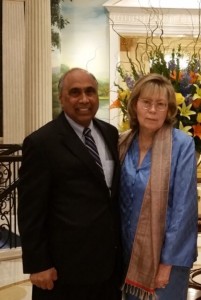
India and Pakistan are bound together by geography, culture, and centuries of flowering of arts and many manifestations of human creativity. Since 1947, highly talented individuals from both sides of the border have excelled in music, films and literature and are very popular across the region. Indeed top actors and singers are household names in both countries.
Yet, almost seven decades after independence and partition, peace between the two nuclear-armed neighbors remains hostage to security, political and diplomatic disputes.
Last week, I had the privilege to be part of the D.C. South Asian Film Festival, which brought together a glittering gathering of upcoming artists, directors and filmmakers. As I hosted the luminaries, I felt the real power of their impressive work. A good independent film or a quality play could strike a harmonious chord so profoundly I felt when I learned about some of the stories centered on the best of human qualities.
This year’s theme, “Art and Culture Transcend Boundaries,” could not have been more appropriate. We are all aware of the ongoing diplomatic and security tensions over Kashmir in South Asia, which still fares far behind the developed world in terms of human resource development and poverty reduction. Despite some admirable stories of progress and economic development, millions of people have still not become part of the mainstream success. Then, there are issues over treatment of minorities, women and health of children.
But I was heartened to note that the participants from both countries and guests from the Washington metro area, shared my feeling that ‘art and culture transcend boundaries.”
This is so even though we live in a deeply divided world. These are unsettling times – – wars, refugees, terrorism, hate crimes of all types, and boundary disputes. Events such as these dominate the headlines daily.
Yet, art and culture elevate and unite all of us. Whether it is a young boy in Afghanistan, or an old woman in Zimbabwe, there is not a soul that doesn’t enjoy a good movie, or a lovely piece of music.
The fact that we had with us some of the finest upcoming talents from India and Pakistan under one roof was a strong proof that art and culture indeed go far beyond boundaries, as creative works celebrate the goodness of human heart and human beings desire for love. At the same time, the works of art point out the flaws in human characters that mar lives and societies.
The works of the filmmakers, who showcased their works, including Aparna Sen, Huma Beg, Suman Ghosh, have a healing and unifying power. The movie on short story writer Saadat Hasan Manto is also brilliant as it deals with societal pressures. Manto had lived on both sides and his work, like other acclaimed writers, and is deeply respected.
In Washington, I have had the good fortune to serve on boards of several educational and arts institutions and firmly believe in the power of human affiliation.
Among attendees of the festival were distinguished Indian actress and filmmaker Aparna Sen, who expressed her support for the festival.
This film festival has become one of the most celebrated South Asian events on our city’s cultural calendar. The way DC South Asian Film Festival has grown in the past three years, I believe that I can safely predict that within the near future it will become one of the biggest South Asian events in the United States.
India and Pakistan have not been able to sort out their differences at the United Nations, and through many Washington interventions. But their regular exchanges and collaborative ventures in music and films – in both South Asia and the United States – holds promise to boost efforts toward peace and harmony for the large part of humanity in South Asia.


